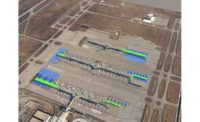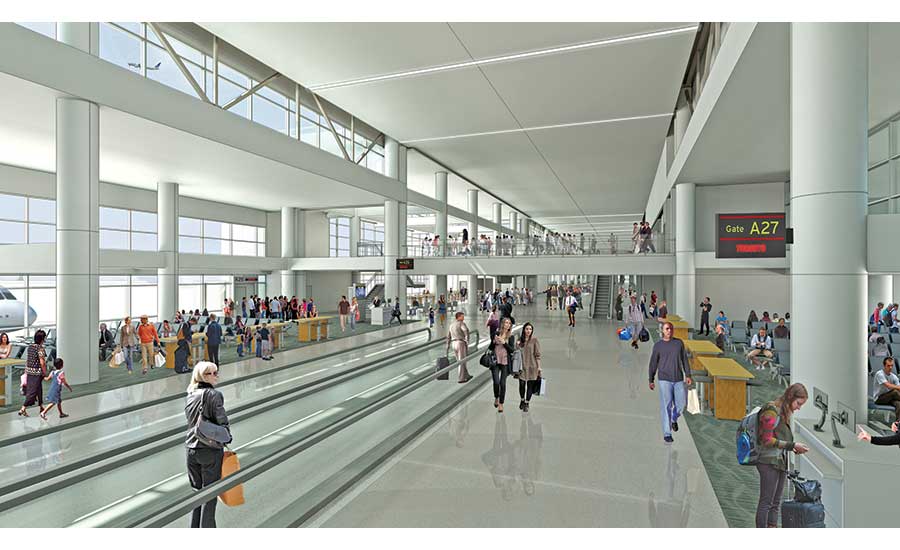2019 Colorado-Wyoming-Dakotas Owner of the Year
Bustling Denver International Airport Launches Major Expansion, Upgrades

The Great Hall Project in DIA’s tent-roofed terminal will enhance security, provide a more flexible and open airline check-in space and add new dining and shopping options.
RENDERING COURTESY OF DIA

The Gate Expansion Project will add 39 airline gates, a 30% increase in capacity, and improve passenger amenities on each of the airport’s three concourses.
RENDERING COURTESY OF DIA

“Our passenger traffic has been growing—five straight years of record traffic.” — Kim Day, CEO, Denver International Airport



Denver’s airport is flying high.
Last year, 64.5 million passengers traveled through its concourses and iconic, tent-capped terminal, making it the fifth-busiest airport in the U.S., according to Federal Aviation Administration statistics that track total takeoffs and landings. That number was up almost 5% over 2017 totals. To top off a heady year, in 2018 The Wall Street Journal named it the best airport in the U.S., citing its reliability, value and convenience.
Denver International Airport (DIA) officials expect the brisk growth to continue, anticipating 80 million passengers by 2025. The increase in traffic is driving more than $3.5 billion in expansion and remodeling. Faced with a facility built to accommodate 50 million annual passengers when it opened in 1995, DIA officials have launched a five-year capital-improvement program that includes 39 new gates (a 30% increase) and renovation of the Great Hall—the airport’s tent-roofed terminal, a central gathering point for travelers and home to a variety of shops and restaurants.
The terminal and concourse projects, both begun last year, are proceeding as private-public partnerships (P3s) involving numerous contractors. The $1.1-billion undertaking in the airport’s Jeppesen Terminal includes the Great Hall renovation plus upgrades to DIA’s people mover and baggage system. The $1.8-billion concourse project includes $1.5 billion in construction costs for the new gates, plus $300 million in concessions, signs, restrooms, new elevators, escalators and moving walkways. An additional $600 million is being spent on airfield improvements, reconditioned roadways and commercial development on airport land not used specifically for aviation.
The Great Hall makeover, budgeted at $770 million ($120 million of that is contingency), is being conducted by a consortium called Great Hall Partners, which consists of Madrid-based Ferrovial Airports, JLC Infrastructure and Saunders Concessions. Hensel Phelps Construction is working on improvements to the baggage system, and the airport will pay for new train cars—replacing some and adding others—for the underground people mover.
The gate expansion project is being managed by two joint ventures—Holder Construction and FCI Constructors Inc. on concourses B-East and C-East and Turner Construction and Flatiron Construction on concourses A-West and B-West.
Revenue Sharing
Gisela Shanahan, the airport’s chief financial officer, says DIA is covering 74% of the design-and-construction cost and will receive 80% of net lease revenue from concessions in the Great Hall and the concourses. The joint-venture partners, she says, are contributing the remainder of the cost and in turn will get 20% of revenue.
The airport’s financing sources for the first three years of the program include cash on hand, about $15 million a year in federal grants and $2.5 billion in new bonds that DIA issued last August. The airport also restructured an additional $300 million in previous bond debt. Shanahan says the bond issue was the largest ever for an aviation project in the U.S., and adds that DIA will borrow “a fairly significant portion of the remaining billion sometime within the next two years, depending on market conditions and our own cash flows.”
DIA CEO Kim Day says the expansion responds to a variety of pressures, especially the Denver metropolitan area’s continued growth. “The catalyst that really got us moving was the fact that Denver is on fire, essentially,” Day says. “We are growing. We are seeing massive in-migration of people who want to live in this wonderful city and work here. As a result, our passenger traffic has been growing—five straight years of record traffic.”
In addition, Day says, “Our airlines are asking for gates. That was one good indicator that it was time we really needed to grow.”
Beyond the need to expand, Day says, the principal motivation for the Great Hall project was to improve the airport’s security layout. Security checkpoints will be moved upstairs from the main floor, which will be returned to what Day describes as a “traveler’s oasis” of shops, restaurants and other revenue-producing amenities.
Faster Security Checks
With the new configuration, DIA’s planners hope to eliminate long screening lines. Instead of queuing up by the hundreds, travelers will be assigned in groups of 30 or 40 to a series of vestibules on the basis of perceived risk—families with children, business passengers using the Transportation Security Administration’s (TSA) PreCheck program and so on. Day says the airport has worked extensively with TSA to introduce new technology, including advanced body scanners. She says DIA will be the first airport in the country to adopt both the new configuration and technology.
The new security checkpoints will replace much of the current ticket lobby, which is used less than before because customers now print their own boarding passes at home or simply carry them on their cellphones. Baggage checks are also becoming a thing of the past in the ticket lobby. Last year, the airport became the first in the nation to introduce a bag-drop service and printing of boarding passes via a private vendor in selected parking lots served by shuttle buses.
“Our passenger traffic has been growing—five straight years of record traffic.”
– Kim Day, CEO, Denver International Airport
Converting the ticket lobby, Day says, will enable the renovated Great Hall to accommodate millions of extra passengers without adding square footage. Still, a central question remains: Even with its plans for trendy, Colorado-themed shops, bars and restaurants, will the traveler’s oasis concept be enough to entice passengers to linger in the Great Hall rather than hurrying through the terminal to clear security checkpoints for their flights, and in turn, create the revenue that DIA and its private-sector partners are banking on?
“If you think about us, we’re 65% O&D (origin and destination) traffic,” Day says. “We have a lot of people who fly often, and who know our airport well. What we’re hoping is that the concessions in the Great Hall are compelling enough that you actually give yourself time to spend a little time there before you get to the gate.”
Labor Squeeze
Excavation began in early April for foundations that will support the new gates, which will extend out from the current concourses. Completion of the 1.4-million-sq-ft greenfield project is set for 2021. Mark Adams, senior project director for the concourse expansion, says despite Denver’s recent severe winter, construction is on schedule.
Even so, Aaron Wiebelhaus, Turner Construction vice president and general manager, believes the schedule “is going be a challenge from start to finish.” He cites Denver’s busy construction market as the main potential barrier to on-time completion and expects what he calls a tug-of-war for subcontractors and labor.
On the operational side, Adams says a key issue will be accommodating up to 1,500 tradespeople during the peak of construction next year. At the north side of the airfield, away from the facility’s passenger access on busy Peña Boulevard, airport management and contractors are setting up what they call a “construction office complex.” It consists of trailers placed on a big parking lot surfaced in concrete recycled from other DIA projects. Tradespeople, all of whom require federal background checks to work at the airport, are being issued badges and must pass through security screening each day when they enter the site.
Although the schedule for the concourses proceeds apace, work on the Great Hall may already have hit a snag. As reported by ENR and other media outlets, preliminary testing showed that portions of the terminal’s concrete floor may have a compressive strength lower than that specified in the airport’s historical documents.
Those tests triggered concerns that the floor might not support the weight of construction cranes needed for the renovation.
DIA spokesperson Emily Williams also said via email that other testing of the aggregate showed “properties that, under certain environmental circumstances, could lead to an alkali-silica reaction (ASR) issue.” ASR is a chemical reaction that breaks down concrete. Potential environmental issues include contact with groundwater, which has not seeped into the terminal, she told ENR.
Experts are now analyzing samples of the concrete floor. Shanahan, the airport’s CFO, says results should be known by late May. Other work continues in the Great Hall, and Williams said via email that “the current samples show no indication of an ASR issue.” She says that “experts in the field of structural engineering have informed us that the airport is safe and can support the construction.”





